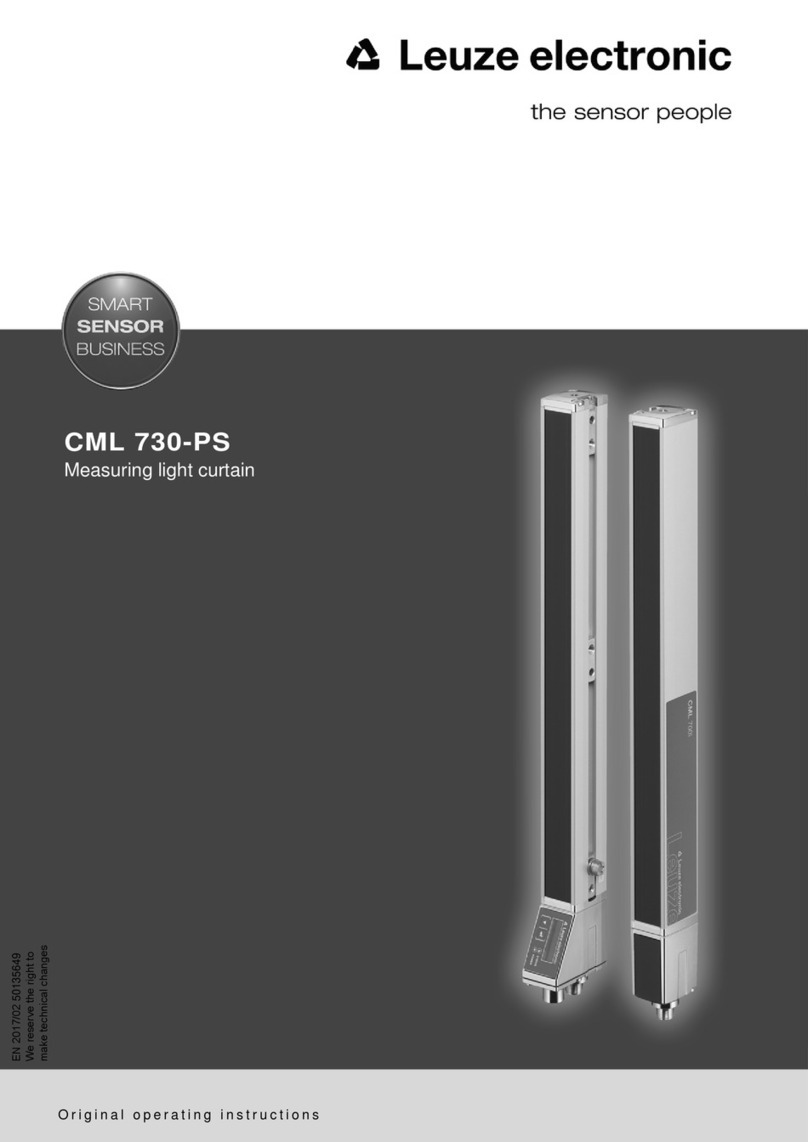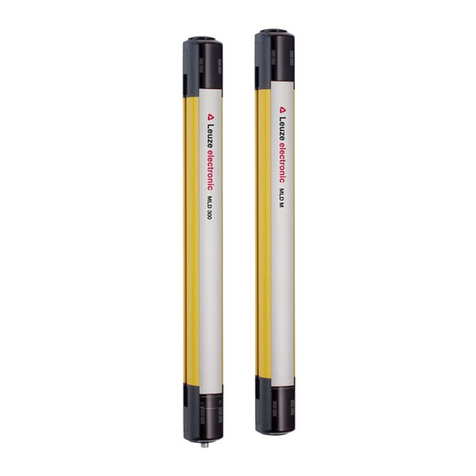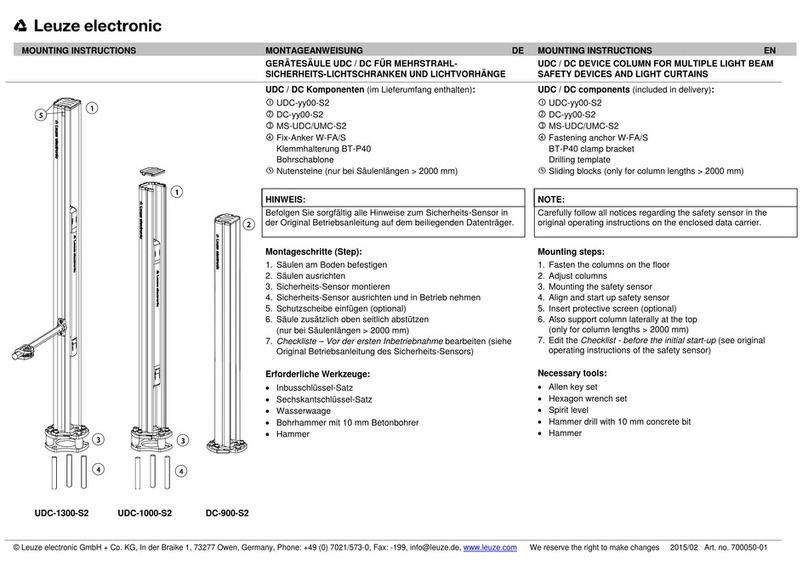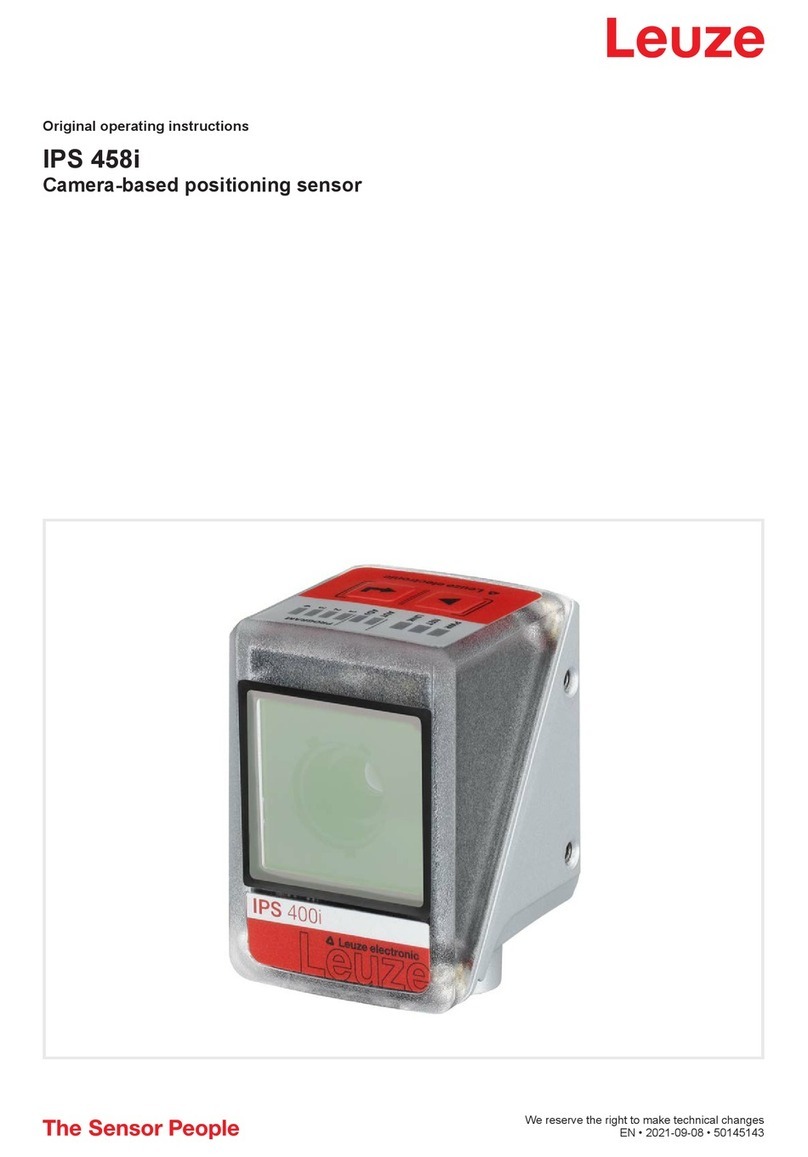
Leuze electronic GmbH + Co. KG In der Braike 1 D-73277 Owen We reserve the right to make changes
2
Adjustment
Flush (shielded) Sensors Non-Flush (unshielded) Sensors
Flush mountable sensors are normally being used for presence detection of objects or for indirect
point level detection of solids, powders or liquids. The following two setup routines help to assure
proper setup and operations. All LCS sensors allow sensitivity adjustment potentiometer.
These capacitive sensors use a larger spherical
electrical field which is especially suited as level
detectors for liquids, granulates or powders.
Object Fluid Plastic
Presence Detection of Solid Objects
The following procedures are outlined for
setting a normally open capacitive sensor for
ideal sensing conditions:
1. Mount the sensor in the actual sensing
position
2. Set up the target for the worst case
condition. This means for a presence
detection application to move the object to
the farthest occurring position from the
sensor.
3. All LCS capacitive sensors are already
factory preset to their maximum
operational sensing range. The sensor has
to move closer to the target object, if the
farthest object position does not assure a
reliable switching. Alternatively, a larger
sensor with a larger sensing range can be
chosen.
4. The sensitivity can now be reduced by
turning the potentiometer CCW until the
sensor switches off. Increase now the
sensitivity
CW by 1/2 turn to set the sensor to its optimal
sensitivity setting.
Example:
In the following example, a shielded capacitive
sensor in a M12 tubular housing will be used to
detect a ceramic plate.
The sensor is factory preset to a maximum
rated switching distance s
n
of 4 mm to metal or
by approximation to your hand. When moving
the sensor towards the target object, the rated
switching distance s
n
to the ceramic plate has
been reduced to approx. 2 mm. This distance is
now the maximum permissible switching
distance for the ceramic plate.
Note:
To ensure that Leuze LCS capacitive sensors
work reliably within their technical specifi-
cations, they have a greater sensing distance
than the indicated maximum rated switching
distance s
n
in the datasheet. If the user decides
to adjust the sensor to a switching distance
greater than 2 mm for the above described
ceramic plate, the sensor will operate in an
unreliable mode. This entails a risk that tem-
perature and other environmental factors or
electrical interferences may lead to unreliable
switching conditions.
Point-Level Detection through Container Walls
Empty Setup (normally open)
1. Mount the sensor in the actual level sensing
position flush to the non-metallic container
wall.
2. All LCS capacitive sensors are already
factory preset to their maximum operational
sensing range. The sensor will initially trigger
on the container wall material.
3. The sensitivity has to be reduced by turning
the potentiometer CCW until the sensor
switches off. Increase now the sensitivity CW
by 1/2 turn to set the sensor to its optimal
sensitivity setting.
4. The sensor should switch on at 40% to 50%
sensing area coverage - readjust the
sensitivity CCW if the coverage is above
50% and CW if it is below 40%.
Full Setup (normally open)
1. Mount the sensor in the actual level sensing
position flush to the non-metallic container
wall.
2. All LCS capacitive sensors are already
factory preset to their maximum operational
sensing range. The sensor will initially switch
on to the container wall.
3. The sensitivity has to be reduced by turning
the potentiometer CCW until the sensor
switches off. Increase now the sensitivity CW
by 1/2 turn to set the sensor to its optimal
sensitivity setting.
4. The sensor should switch on at 40% - 50%
sensing area coverage - readjust the
sensitivity CCW if the coverage is above
50% and CW if it is below 40%.
Note:
The partition wall may only be made of glass or
plastic. A rule of thumb for the maximum
thickness of the wall yields a value of approx.
10 to 20% of the sensor‘s rated switching
distance, but max. 4 mm.
Direct Point-Level detection
Full Setup (normally open)
1. Mount the sensor in the actual level
sensing position with regards to the
minimum clearance guide line in our
mounting reference.
2. All LCS capacitive sensors are already
factory preset to their maximum
operational sensing range. The sensor will
initially switch on contact with the target
material.
3. The sensitivity has to be reduced by
turning the potentiometer CCW until the
sensor switches off. Now increase the
sensitivity CW by 1/2 turn to set the sensor
to its optimal sensitivity setting.
This setup procedure assures that the influence
of temperature and material build-up has been
reduced to a minimum. In some instances,the
target material creates extensive material build-
up or has a very high relative dielectric constant
(conductivity) leading to uncontrollable
repetitive false triggering.
CCW = counter-clockwise
CK = clockwise
① Metal
② Ceramic
① Wall thickness (max. 4 mm glass or plastic)
② Wate
① Wall
② Plastic granulate
Important: Different material properties and conditions have to be taken into consideration during
the calibration process. All Leuze LCS capacitive sensors are therefore equipped with highly
accurate trim potentiometers to adjust the device‘s sensitivity. Turning the potentiometer clockwise
(CW) increases the sensitivity, whereas counter-clockwise (CCW) turning reduces it.























